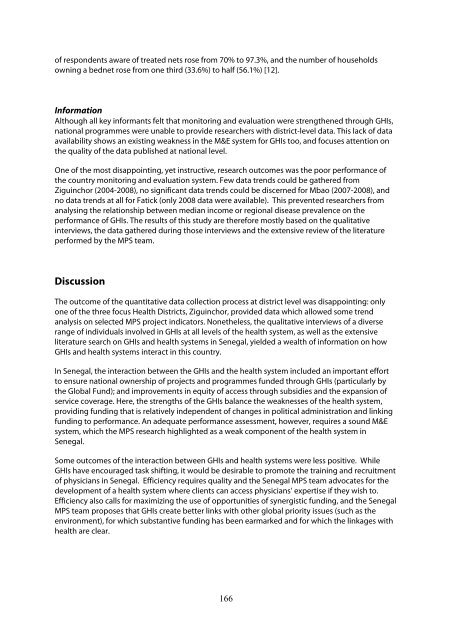MAXIMIZING POSITIVE SYNERGIES - World Health Organization
MAXIMIZING POSITIVE SYNERGIES - World Health Organization
MAXIMIZING POSITIVE SYNERGIES - World Health Organization
You also want an ePaper? Increase the reach of your titles
YUMPU automatically turns print PDFs into web optimized ePapers that Google loves.
of respondents aware of treated nets rose from 70% to 97.3%, and the number of households<br />
owning a bednet rose from one third (33.6%) to half (56.1%) [12].<br />
Information<br />
Although all key informants felt that monitoring and evaluation were strengthened through GHIs,<br />
national programmes were unable to provide researchers with district-level data. This lack of data<br />
availability shows an existing weakness in the M&E system for GHIs too, and focuses attention on<br />
the quality of the data published at national level.<br />
One of the most disappointing, yet instructive, research outcomes was the poor performance of<br />
the country monitoring and evaluation system. Few data trends could be gathered from<br />
Ziguinchor (2004-2008), no significant data trends could be discerned for Mbao (2007-2008), and<br />
no data trends at all for Fatick (only 2008 data were available). This prevented researchers from<br />
analysing the relationship between median income or regional disease prevalence on the<br />
performance of GHIs. The results of this study are therefore mostly based on the qualitative<br />
interviews, the data gathered during those interviews and the extensive review of the literature<br />
performed by the MPS team.<br />
Discussion<br />
The outcome of the quantitative data collection process at district level was disappointing: only<br />
one of the three focus <strong>Health</strong> Districts, Ziguinchor, provided data which allowed some trend<br />
analysis on selected MPS project indicators. Nonetheless, the qualitative interviews of a diverse<br />
range of individuals involved in GHIs at all levels of the health system, as well as the extensive<br />
literature search on GHIs and health systems in Senegal, yielded a wealth of information on how<br />
GHIs and health systems interact in this country.<br />
In Senegal, the interaction between the GHIs and the health system included an important effort<br />
to ensure national ownership of projects and programmes funded through GHIs (particularly by<br />
the Global Fund); and improvements in equity of access through subsidies and the expansion of<br />
service coverage. Here, the strengths of the GHIs balance the weaknesses of the health system,<br />
providing funding that is relatively independent of changes in political administration and linking<br />
funding to performance. An adequate performance assessment, however, requires a sound M&E<br />
system, which the MPS research highlighted as a weak component of the health system in<br />
Senegal.<br />
Some outcomes of the interaction between GHIs and health systems were less positive. While<br />
GHIs have encouraged task shifting, it would be desirable to promote the training and recruitment<br />
of physicians in Senegal. Efficiency requires quality and the Senegal MPS team advocates for the<br />
development of a health system where clients can access physicians’ expertise if they wish to.<br />
Efficiency also calls for maximizing the use of opportunities of synergistic funding, and the Senegal<br />
MPS team proposes that GHIs create better links with other global priority issues (such as the<br />
environment), for which substantive funding has been earmarked and for which the linkages with<br />
health are clear.<br />
166

















